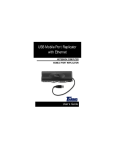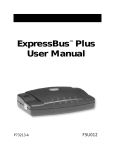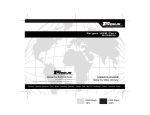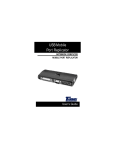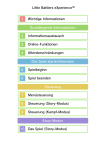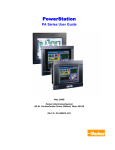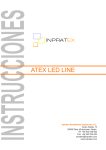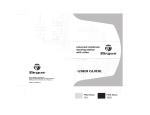Download Targus Mobile Docking Station
Transcript
4ARGUSÖ0ORT 2EPLICATOR -AKINGÖ9OURÖ-OBILEÖ,IFEÖ%ASIERË 6ISITÖOURÖ7EBÖSITEÖATÖWWWTARGUSCOM &EATURESÖANDÖSPECIFICATIONSÖAREÖSUBJECTÖTOÖCHANGEÖWITHOUTÖNOTICE ¬ÖÖÖ4ARGUSÖ'ROUPÖ)NTERNATIONALÖANDÖ4ARGUSÖ)NC ! BRUSSELS HANNOVER BARCELONA TOKYO MILANO AMSTERDAM SINGAPORE 53%23Ö'5)$% -AKINGÖ9OURÖ-OBILEÖ,IFEÖ%ASIERË LONDON PARIS NEW YORK LOS ANGELES TORONTO HONG KONG SYDNEY Introduction Congratulations on your purchase of the Targus USB Mobile Port Replicator. This ultra portable expansion module directly connects to a desktop or notebook computer via a Universal Serial Bus (USB) port. The port replicator provides the following ports: • • • • • PS/2® (two) RS232 serial Parallel (printer) High-speed USB 2.0 (two) RJ-45 Ethernet 10/100 Base T (Model PA095 only) Contents In addition to this user’s guide, the package contains: • Targus USB Mobile Port Replicator • 2-foot (60 cm) USB cable (A/B type) (Model PA075 only) • Driver software CD • AC power adapter NOTE: The supplied AC power adapter is a universal adapter that you can use in a 100 to 240 AC volt outlet. System Requirements • USB 2.0 compliant port (When connected to a USB v1.1 upstream port, the Mobile Port Station's performance will be less than optimal. For best results, connect it to a USB 2.0 port.) • Windows® 2000/XP operating system • CD-ROM Drive 2 WARNING: You must install the port replicator software BEFORE connecting it to your computer. Otherwise, the port replicator will not work properly. Installing the Port Replicator Drivers 1 Turn on your computer. 2 Insert the driver software CD into your computer’s CDROM drive. 3 If setup does not begin automatically, click Start, Run, then enter D:\Setup.exe (where D: is the path of your CDROM drive) and then click OK. The Welcome screen appears. 4 Click Next. 5 If you are running the Windows® XP operating system, the Important Information screen appears. Click Next. The Setup program begins installing the software drivers. NOTE: If you get a warning screen, please click ‘continue anyway’. The Setup Complete screen appears. 6 Click Finish. Connecting the Port Replicator to Your Computer After installing the port replicator drivers, you are ready to connect the port replicator to your computer. To do this: 3 1 Turn off your computer. 2 (Model PA095 only) Open the USB cable compartment, located on the bottom of the port replicator, and uncoil the cable. 3 Connect the supplied AC power adapter to the AC power jack on the port replicator. 4 Plug the USB connector end of the USB cable into the USB port of your computer. 5 Turn on your computer. The following will configure automatically: • • • • • Ethernet 10/100 (Model PA095 only) Serial Interface Controller USB Device (twice) Parallel Interface Controller PS/2 Adapter (twice) This configuration process takes a few minutes. The operating system does not prompt when configuration is complete. Watch that all hardware devices are configured before opening another application or connecting devices to the port replicator. NOTE: some hardware devices may prompt you for the location of device drivers. To install the drivers: 1 Select “Install the software automatically (Recommended)” and click Next. The Found New Hardware Wizard program begins installing the hardware drivers. 4 The Completing the Found New Hardware Wizard screen appears. 2 Click Finish and repeat as needed for each device. 3 Restart your computer. When your computer restarts, the port replicator/dock should be completely configured. LED Status Indicator Lights Once all device drivers are installed, the LED status indicator lights glow and you can connect devices to the port replicator. The LED lights display as follows: • Hub Link light blinks green. • Serial light glows green. • Each PS/2 light flashes green when a device is first connected or there is activity on the port. • USB lights glow green when a USB device is attached. (Model PA095 only) • Tx/Rx light flashes green when data is transmitted to or from the network. • 100M light glows green when connected to a 100 Mbps network. NOTES: The Ethernet port is compatible with 100 Mbps networks. however, the actual throughput is 10 Mbps maximum when connected to a USB v1.1 port due to the bandwidth limitation. The throughput may decrease as additional devices are attached to the port replicator regardless of whether the port replicator is attached to a USB 1.1 or 2.0 port. 5 The port replicator supports hot swapping of the network cable. Connecting Devices to the Port Replicator When connecting new devices to the port replicator, you may need to install additional software drivers. Consider the following guidelines: • The device drivers install automatically. • When connecting a new device to the port replicator, you must run the Setup or Install program for that device. • When connecting a device to the port replicator, do not force the cable connector into the port on the port replicator, to avoid possible damage. If the cable connector does not attach smoothly, turn the connector over and try attaching it again. AC PS/2 PS/2 power keyboard mouse Parallel RS232 Parallel Serial Model PA095 RS232 Serial Model PA075 6 PS/2 Keyboard RJ-45 ethernet PS/2 Mouse PS/2 Port To connect a PS/2 device, such as a mouse or keyboard, plug it into a PS/2 port on the port replicator and begin using the device. Serial Port Connecting and Configuring a Modem To connect a serial modem: 1 Attach the cable connector to the serial port on the port replicator. 2 Install the modem software driver according to the instructions that come with the device. 3 When prompted to select the port, choose the Serial USB (COMx), where x is the COM port number assigned by your operating system. Connecting a Handheld Computer To connect a handheld computer: 1 Attach the cable connector to the serial port on the port replicator. 2 Verify that the COM port setting, in either your HotSync® or ActiveSync® software, matches the setting on the port replicator. To verify the COM port setting on the port replicator, refer to “Verifying Devices are Installed” on page 11. To verify the COM port setting on your handheld computer, refer to the documentation that came with it. 7 Parallel Port Connecting and Configuring a Printer for the First Time To connect a parallel printer: 1 Attach the cable connector to the parallel port on the port replicator. 2 Install the printer software driver according to the instructions that come with the device. 3 When prompted to select a port, choose PB1284-1 (USB port). If this port does not appear in the list, choose the LPT1 port, complete the manufacturer’s setup for your printer, and follow the instructions below to redirect your printer. Checking and Redirecting the Printer Port Settings Follow these instructions to check the printer port settings and redirect your printer from the LPT1 port to the PB12841 (USB port) on the port replicator. 1 Unplug the printer cable from your computer and plug it into the port replicator parallel port. 2 Select Start, Settings, and then Printers. 3 Right-click the printer device you are reassigning and select Properties. 4 In the Printer Properties window, select Details or Connection for the Printer. (Section titles vary, so check your printer’s user manual for specific instructions.) 5 Change the setting to PB1284-1 (USB port) to redirect printing to the port replicator. 8 (Model PA095 only) Ethernet Port To connect an RJ-45 Ethernet cable, attach the cable connector to the Ethernet port on the port replicator. Additional procedures to connect to an actual network depend on the type of network you are using. Contact your network administrator for detailed instructions. USB Port To connect a USB device, plug it into a USB port on the port replicator and follow the additional instructions provided with the device. Special Notes Using a Device with the Port Replicator When you connect a device to the USB Mobile Port Replicator, you should be able to use it as you normally would. NOTE: devices that support custom programmability or special features may not function properly. For more information on using a device, refer to the instructions provided with the device. Global Suspend Mode When your computer is in suspend mode, the port replicator also enters suspend mode to avoid power consumption. When your computer wakes up, the port replicator wakes up automatically. 9 Product Limitations General The port replicator splits a single connection among a variety of devices and connections. Some devices, which use large amounts of bandwidth, such as printers and digital cameras, can consume all available resources and may interfere with the performance of other devices. You may experience some temporary halting of some devices when a high data transfer is occurring. For example, your mouse may respond slowly while a graphic print job is printing or while you are experiencing heavy network traffic. We recommend the following guidelines: • Do not transfer data to or from multiple high-speed devices at the same time, such as a digital camera and scanner. • If speed degradation does occur, close other programs that use a USB device to improve device performance. Parallel Port The parallel port is only compatible with printers and only supports enhanced bi-directional printer features, such as returning printer status. For best results, you should connect high bandwidth external devices, which have a parallel connection, such as a Zip® drive, directly to your computer. PS/2 Mouse and Keyboard On the port replicator, a PS/2 mouse emulates a USB mouse and a PS/2 keyboard emulates a USB keyboard. This may result in a loss of enhanced features, such as screen scrolling or programmable hot key features. 10 However, the mouse will continue to work as a standard, two-button mouse and the keyboard as a standard keyboard. Troubleshooting Device Not Working • Make sure that the device is fully inserted into the correct port on the port replicator. • Plug the device into a different port on the port replicator. If it still doesn’t work, test the device by connecting it directly to your computer. • Verify that you ran the Setup or Install program for the device. • Make sure that the device appears in Device Manager. For more information refer to “Verifying Devices are Installed” on page 11. • Disconnect all devices from the port replicator and reconnect them, one at a time. Check that each device works before plugging in the next one. Printer Not Found If your parallel printer is not working, refer to “Checking and Redirecting the Printer Port Settings” on page 8 for instructions on how to verify and change the port settings. Verifying Devices are Installed You can view the devices installed on the port replicator from the Device Manager window in System Properties. Right-click My Computer, Properties, then click the Hardware tab, and then the Device Manager button. 11 Sample Device Manager tab (Windows® XP operating system) From the Device Manager window, expand the following: • Human Interface Devices — displays PS/2 Keyboard and Mouse Adapter when a PS/2 device is plugged in. • Network adapters — displays USB Ethernet 10/100 (Model PA095 only) • Ports (COM & LPT) — displays the Serial on USB [COM 2] port • Universal Serial Bus controllers — displays the other devices installed for the port replicator. (USB hub, composite device, and printing support) Verifying a Serial Modem Connection When attaching a modem to the serial (RS232) port, verify that the port assigned to your modem is Serial USB (COMx), where x is the number of the COM port. 12 If the operating system does not detect automatically that your modem is assigned to Serial USB (COMx), rerun the Hardware Wizard and choose Select from a list instead of Autodetect. Then, select Serial USB (COMx) as the COM port. Error Message on Your Handheld Computer If the error message “Connection Not Established” appears on your handheld computer, check that the COM port setting in either your HotSync or ActiveSync software, matches the setting on the port replicator, see “Verifying Devices are Installed” on page 11 to verify the COM port setting on the port replicator. You may also want to try reducing your baud rate setting in Hot Sync or Active Sync. Some older versions of the Palm® Desktop software are not compatible with the USB to Serial conversion. Please contact your handheld computer vendor for software updates. 13 Technical Support For technical questions please visit: Internet: www.targus.com/support.asp Product Registration Targus recommends that you register your Targus accessory shortly after purchasing it. To register your Targus accessory, go to: http://www.targus.com/registration.asp You will need to provide your full name, email address, phone number, and company information (if applicable). Warranty Targus warrants this product to be free from defects in materials and workmanship for one year. If your Targus accessory is found to be defective within that time, we will promptly repair or replace it. This warranty does not cover accidental damage, wear and tear, or consequential or incidental loss. Under no conditions is Targus liable for loss of, or damage to a computer; nor loss of, or damage to, programs, records, or data; nor any consequential or incidental damages, even if Targus has been informed of their possibility. This warranty does not affect your statutory rights. Warranty Registration at: http://www.targus.com/registration.asp Regulatory Compliance This device complies with Part 15 of the FCC Rules. Operation is subject to the following two conditions: (1) This device may not cause harmful interference, and (2) This device must accept any interference received, including interference that may cause undesired operation. 14 FCC Statement Tested to Comply This equipment has been tested and found to comply with the limits of a Class B digital device, pursuant to Part 15 of the FCC Rules. These limits are designed to provide reasonable protection against harmful interference in a residential installation. This equipment generates, uses, and can radiate radio frequency energy and if not installed and used in accordance with the instructions, may cause harmful interference to radio communications. However, there is no guarantee that interference will not occur in a particular installation. If this equipment does cause harmful interference to radio or television reception, which can be determined by turning the equipment off and on, the user is encouraged to try to correct the interference by one or more of the following measures: • Reorient or relocate the receiving antenna • Increase the separation between the equipment and receiver • Move the computer away from the receiver • Connect the equipment into an outlet on a circuit different from that to which the receiver is connected. Windows and ActiveSync are registered trademarks of Microsoft Corporation. Palm and HotSync are a registered trademarks of Palm, Inc. PS/2 is a registered trademark of International Business Machines Corporation. Zip drive is a registered trademark of Iomega Corporation.Features and specifications are subject to change without notice. All other trademarks and registered trademarks are the property of their respective owners. (c) 2004 Targus Group International and Targus, Inc., Anaheim, CA 92806. 15















